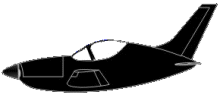
ASN Wikibase Occurrence # 45429
This information is added by users of ASN. Neither ASN nor the Flight Safety Foundation are responsible for the completeness or correctness of this information.
If you feel this information is incomplete or incorrect, you can submit corrected information.
| Date: | Friday 13 September 2002 |
| Time: | 14:40 |
| Type: |  Questair M-20 Venture |
| Owner/operator: | Tommy E. Rose |
| Registration: | N360 |
| MSN: | 75 |
| Total airframe hrs: | 421 hours |
| Engine model: | Continental IO-550 |
| Fatalities: | Fatalities: 1 / Occupants: 1 |
| Aircraft damage: | Destroyed |
| Category: | Accident |
| Location: | Reno-Stead Airport, NV (4SD) -
 United States of America United States of America
|
| Phase: | Manoeuvring (airshow, firefighting, ag.ops.) |
| Nature: | Demo/Airshow/Display |
| Departure airport: | Reno-Stead Airport, NV (4SD) |
| Reno-Stead Airport, NV (4SD) | |
| Investigating agency: | NTSB |
| Confidence Rating: |
The amateur-built experimental airplane sustained a structural failure of the left and right horizontal stabilizers and the associated elevators while participating in the sport class race as part of the annual Reno Air Races. Following the structural failure of the stabilizers and elevators, the airplane dove into the ground. FAA inspectors monitoring air race activities responded to the accident site and interviewed witnesses. The accident occurred about halfway through the sport class race. As the airplane was rounding pylon No. 1, the horizontal stabilizers and elevators began flexing (one witness said the airplane began a shallow porpoise just before the crash) and then bent down. The airplane then dove into the ground. On-site assessment of the wreckage disclosed that the horizontal stabilizers and elevators remained attached to the empennage; however, they were bent down at an acute angle at a point about 2 feet outboard from the root on each side. The airplane was extensively fragmented and control system continuity could not be established on scene. The airspeed indicator was recovered in the debris; the needle was trapped between the fractured glass and the instrument face at the 300-knot/red line. Official timers for the Reno Air Races reported to FAA inspectors that based on time over the measured course distance, the airplane was doing 330 knots just before the accident. The present owner of the design rights for this experimental kit-built all metal airplane said that the airplane was designed by professional aircraft design engineers who worked for a major general aviation manufacturer. The airplane was designed with a gross weight design maneuvering speed (Va) of 156 knots indicated airspeed (KIAS). Never exceed speed (Vne) is 300 KIAS, and the maximum structural cruising speed (Vno) is 265 KIAS. During the design and prototype development, a ground vibration test (GVT) survey was performed, with no excitable nodes found within the airplane's anticipated envelope. The flight test program validated that flutter could not be excited up to Vne. The design owner said that during the developmental flight test work with the prototype, it was flown one time without an artificial force feel limiting device in the elevator control circuit. The stick force per g without the force feel/limiters is less than a pound of control force. During that flight the test pilots encountered a very severe pilot induced oscillation (PIO). A spring assembly was devised for the elevator control circuit to impart a 10-pound per g force feel feed back in the elevator controls to prevent PIO. Examination of the wreckage disclosed that the spring in the elevator force feel/limiter assembly was the wrong size and had only 30 percent of the required tension. Other discrepancies were noted concerning the bushings and bearings in the elevator attachments and the construction workmanship.
Probable Cause: the overload failure of the horizontal stabilizers and elevators due to a pilot induced oscillation at a speed at or above Vne, which exceeded the design stress limits of the structure. Also causal was the intentional alteration by an unknown person or persons of the elevator down spring assembly, which likely reduced the stick force per G from a nominal 10 pounds to less than 1, and led to the pilot induced oscillation. An additional cause was the pilot's decision to operate the aircraft at, above, or near never exceed speed.
Accident investigation:
 |
|
Sources:
NTSB: https://www.ntsb.gov/_layouts/ntsb.aviation/brief.aspx?ev_id=20020919X05182&key=1
Location
Media:
Revision history:
| Date/time | Contributor | Updates |
|---|---|---|
| 28-Oct-2008 00:45 | ASN archive | Added |
| 21-Dec-2016 19:24 | ASN Update Bot | Updated [Time, Damage, Category, Investigating agency] |
| 09-Dec-2017 17:49 | ASN Update Bot | Updated [Operator, Source, Narrative] |
| 08-Dec-2020 21:06 | harro | Updated [Location, Departure airport, Destination airport, Embed code] |
Corrections or additions? ... Edit this accident description
The Aviation Safety Network is an exclusive service provided by:


 ©2024 Flight Safety Foundation
©2024 Flight Safety Foundation